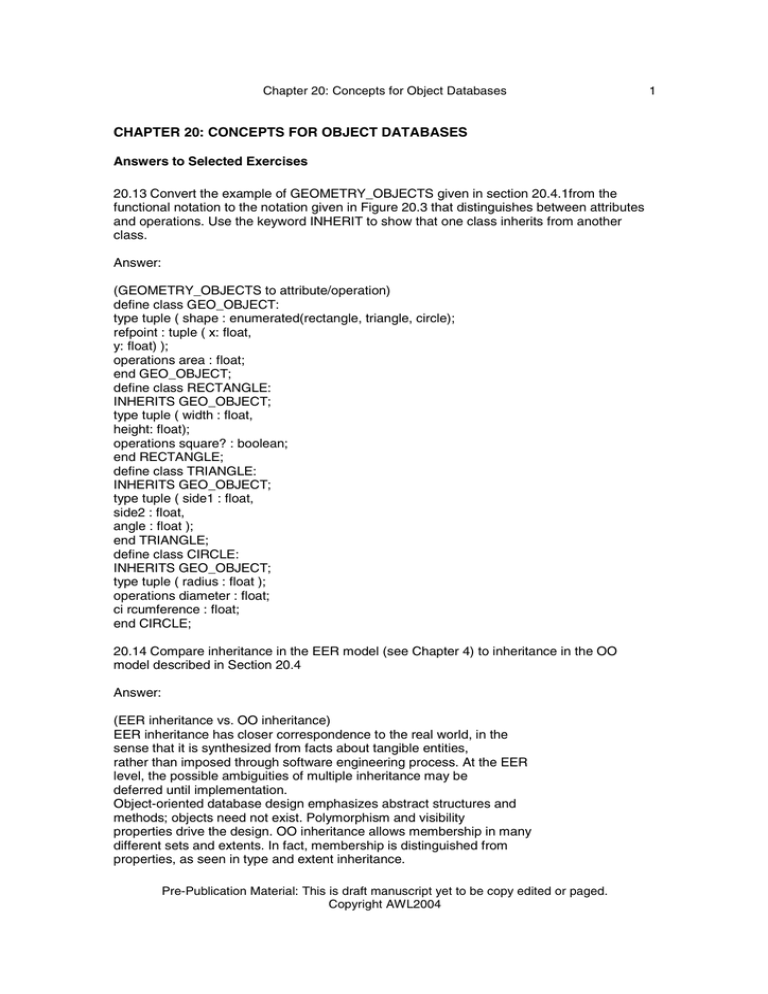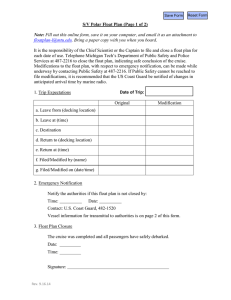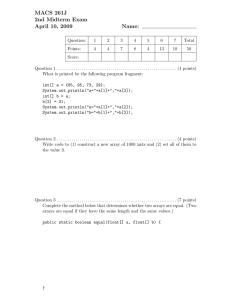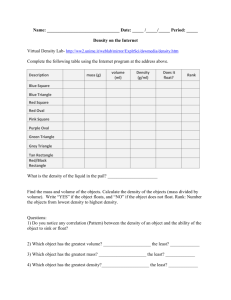CHAPTER 20: CONCEPTS FOR OBJECT DATABASES
advertisement

Chapter 20: Concepts for Object Databases CHAPTER 20: CONCEPTS FOR OBJECT DATABASES Answers to Selected Exercises 20.13 Convert the example of GEOMETRY_OBJECTS given in section 20.4.1from the functional notation to the notation given in Figure 20.3 that distinguishes between attributes and operations. Use the keyword INHERIT to show that one class inherits from another class. Answer: (GEOMETRY_OBJECTS to attribute/operation) define class GEO_OBJECT: type tuple ( shape : enumerated(rectangle, triangle, circle); refpoint : tuple ( x: float, y: float) ); operations area : float; end GEO_OBJECT; define class RECTANGLE: INHERITS GEO_OBJECT; type tuple ( width : float, height: float); operations square? : boolean; end RECTANGLE; define class TRIANGLE: INHERITS GEO_OBJECT; type tuple ( side1 : float, side2 : float, angle : float ); end TRIANGLE; define class CIRCLE: INHERITS GEO_OBJECT; type tuple ( radius : float ); operations diameter : float; ci rcumference : float; end CIRCLE; 20.14 Compare inheritance in the EER model (see Chapter 4) to inheritance in the OO model described in Section 20.4 Answer: (EER inheritance vs. OO inheritance) EER inheritance has closer correspondence to the real world, in the sense that it is synthesized from facts about tangible entities, rather than imposed through software engineering process. At the EER level, the possible ambiguities of multiple inheritance may be deferred until implementation. Object-oriented database design emphasizes abstract structures and methods; objects need not exist. Polymorphism and visibility properties drive the design. OO inheritance allows membership in many different sets and extents. In fact, membership is distinguished from properties, as seen in type and extent inheritance. Pre-Publication Material: This is draft manuscript yet to be copy edited or paged. Copyright AWL2004 1 2 Chapter 20: Concepts for Object Databases 20.15 Consider the UNIVERSITY EER schema of Figure 4.10. Think of what operations are needed for the entity types/classes in the schema. Do not consider constructor and destructor operations. Answer: (University database operations) define class PERSON: operations change-address (new : Address) : Address; define class COURSE: operations new-section ( Yr, Qtr : integer ) : Section; get-current : set ( cur-sec : Current_Section ); change-dept ( new-dept : Department ) : Course; define class STUDENT: operations change-major ( new : Major ) : Student; register ( sec : Current_Section ) : boolean; g et-transcript : set ( tuple ( course-taken : Course; grade : char; ) ); define class FACULTY: operations call-comm-meeting ( S : Student ) : set ( Faculty ); compute-support : float; change-dept ( new-dept : Department ) : Faculty; make-chairman ( dept : Department ) : Faculty; Many other operations are possible, as well. 20.16 Consider the COMPANY ER schema of Figure 3.2. Think of what operations are needed for the entity types/classes in the schema. Do not consider constructor and destructor operations. Answer: (Company database operations) define class EMPLOYEE: operations raise-salary ( pct : float ) : boolean; change address ( new : Address ) : boolean; get-age : integer; get-supervisor : Employee; get-supervisees : set ( Employee ); show-projects : set ( tuple ( Pname : Project, hours : integer ) ); show-dependents : set ( Dependent ); define class DEPARTMENT: operations count-emps : integer; get-manager : Employee; get-locations : set ( String ); list-controlled-projects : set ( Project ); define class PROJECT: Pre-Publication Material: This is draft manuscript yet to be copy edited or paged. Copyright AWL2004 Chapter 20: Concepts for Object Databases operations get-department : Department; show-emp-hours : float; show-dept-contributions : set ( tuple ( D : Department, set ( tuple ( emp : Employee, hrs : integer ) ) ) ); Many other operations are possible, as well. Pre-Publication Material: This is draft manuscript yet to be copy edited or paged. Copyright AWL2004 3






